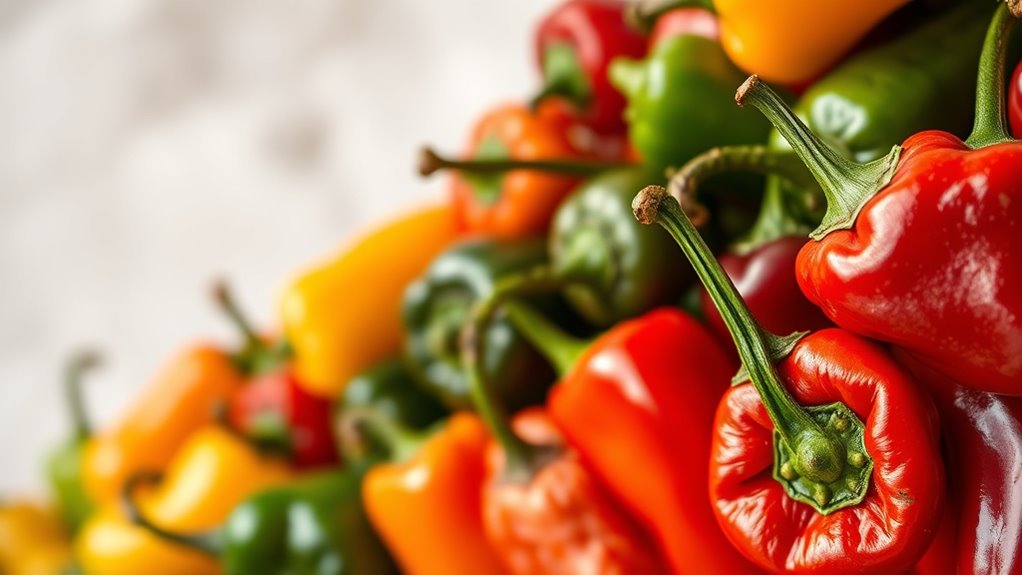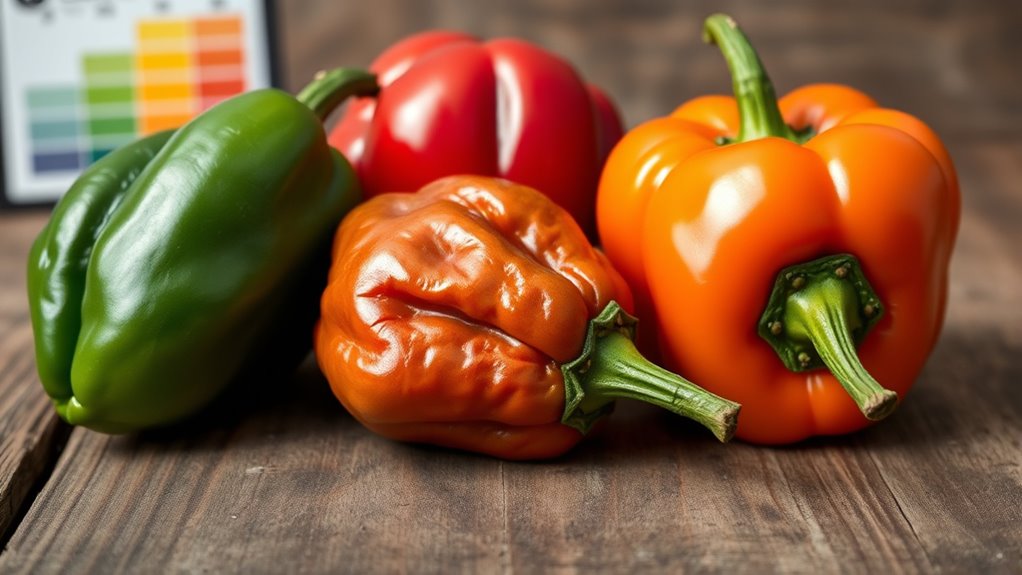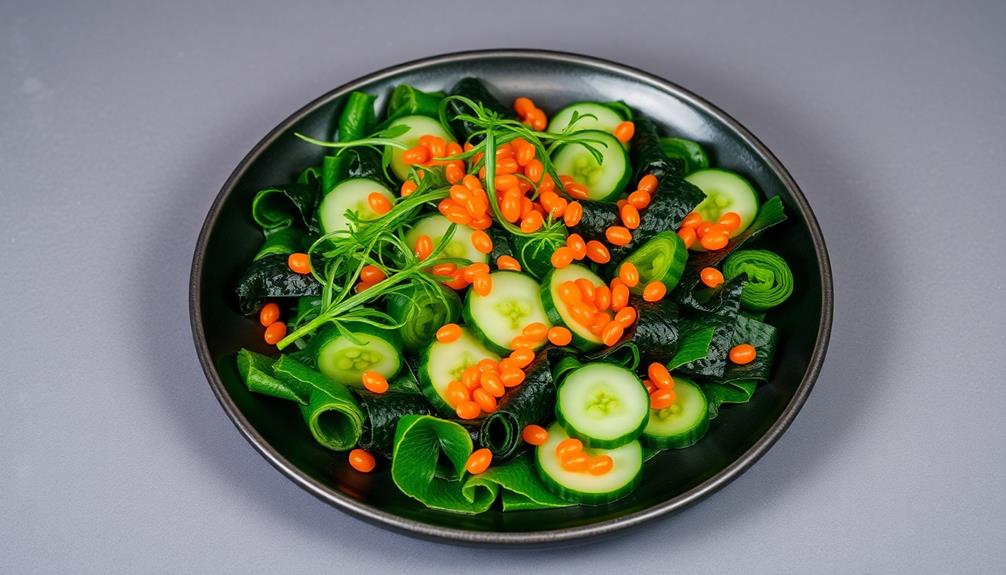To understand heat levels in peppers, focus on the Scoville scale, which measures capsaicin content for consistent spice ratings. Recognize that peppers with similar heat can have different flavor profiles, affecting taste and experience. Starting with lower-rated peppers helps build tolerance, while high-Scoville options suit seasoned spice lovers. Modern testing technology guarantees accurate measurements, so you get reliable results every time. Keep exploring, and you’ll discover how to choose peppers that perfectly match your spice preference.
Key Takeaways
- The Scoville scale ranks peppers based on capsaicin content, providing a standardized measure of heat.
- Modern testing techniques improve the accuracy and consistency of Scoville ratings for better pepper selection.
- Understanding the scale helps match peppers to desired spice levels, from mild to extremely hot.
- Recognizing flavor profiles alongside heat levels enhances culinary pairing and overall tasting experience.
- Knowing your spice tolerance allows you to choose peppers that are enjoyable and safe for your palate.

Heat levels can often be confusing, but understanding how they work is vital for making safe and enjoyable choices. When exploring different peppers, it’s helpful to know how their heat is measured and what that means for your palate. The Scoville scale, which ranks peppers based on their capsaicin content, provides a useful guide, but it’s just the beginning. To truly enjoy the variety of peppers available, you need to consider their pepper flavor profiles and your spice tolerance levels. These factors influence how much heat you can handle and how you’ll perceive the taste and aroma of each pepper. Recognizing the importance of properly measuring heat helps you make better choices for your culinary adventures. Pepper flavor profiles vary widely, even among those with similar heat levels. Some peppers have a fruity, smoky, or earthy aroma that complements their spiciness, while others may taste more straightforwardly hot. For example, a jalapeño offers a bright, grassy flavor with moderate heat, making it versatile in many dishes. On the other hand, a habanero provides intense heat paired with a fruity, citrusy flavor that can overwhelm the unprepared. Recognizing these flavor profiles helps you select peppers that match your preferences and the dishes you’re preparing. Keep in mind that the heat isn’t just a number; it influences the overall sensory experience. Your spice tolerance levels play a vital role in how you experience different peppers. If you’re new to spicy foods, starting with lower Scoville ratings—like bell peppers or banana peppers—allows you to enjoy the flavors without overwhelming heat. As your tolerance develops, you might venture into medium-range peppers such as jalapeños or serranos, which add a noticeable kick without being overpowering. For seasoned spice lovers, high-Scoville peppers like ghost peppers or Carolina reapers provide an intense heat that can be both thrilling and challenging. It’s important to listen to your body and gauge how much heat you can comfortably handle. Over time, you may find your spice tolerance levels increase, opening up a whole new world of fiery flavors. Knowing your own spice tolerance and understanding pepper flavor profiles can help you navigate the Scoville scale with confidence. Additionally, accurate heat measurement, including modern testing techniques, can provide more consistent results compared to subjective perceptions, ensuring you select peppers suitable for your desired spice level. Being aware of the technology used in measuring heat can improve the precision of your choices and enhance your culinary adventures. Don’t assume that hotter always means better; instead, look for peppers that balance heat with flavor, depending on your preferences. Whether you prefer a gentle warmth or a fiery punch, being mindful of these factors ensures you enjoy your spicy experiences safely. Remember, experimenting gradually and paying attention to how each pepper affects you will build your confidence and help you discover your perfect heat level. With this knowledge, you’ll be able to explore the diverse world of peppers and enjoy every bite without discomfort or surprise.
Frequently Asked Questions
How Does the Scoville Scale Compare to Other Spice Measurement Systems?
When comparing the Scoville scale to other spice measurement systems, you’ll notice it’s mainly based on measurement accuracy through subjective taste tests, which can lead to scale limitations. Unlike more precise methods like high-performance liquid chromatography (HPLC), the Scoville scale isn’t as exact. Still, it’s practical for everyday use, helping you gauge heat levels quickly, even if it doesn’t provide perfect precision.
Can the Scoville Scale Predict the Actual Heat of a Pepper?
You wonder if the Scoville scale can predict a pepper’s actual heat. While it provides a useful measure of measuring heat, its accuracy isn’t perfect. Factors like growing conditions and ripeness can affect the heat level, so the scale offers an estimate rather than an exact prediction. Overall, the Scoville scale gives you a good idea, but keep in mind that real-world heat may vary slightly.
Are There Health Risks Associated With Extremely Hot Peppers?
Did you know that consuming extremely hot peppers can cause capsaicin overdose in some cases? It’s rare but possible, leading to stomach pain, nausea, or even more serious issues. If you have spicy food allergies, hot peppers could trigger reactions. You should be cautious with very spicy foods, especially if you’re sensitive or have underlying health conditions, to avoid unwanted health risks.
How Should I Store Hot Peppers to Maintain Their Heat?
To maintain your hot peppers’ heat, focus on proper pepper preservation through correct storage temperature. Keep them in a cool, dry place or in the fridge’s crisper drawer. For longer storage, consider freezing or drying your peppers. Always use airtight containers to prevent moisture loss and preserve their spiciness. Proper storage helps retain their heat, flavor, and freshness, ensuring you get the most out of every pepper you use.
Do Different Growing Conditions Affect a Pepper’S Scoville Rating?
Different growing conditions, like soil nutrients and climate effects, can influence a pepper’s heat level. Rich soil with proper nutrients helps peppers develop their full potential, but extreme conditions like excessive heat or drought can stress plants, sometimes increasing capsaicin production and boosting heat. Conversely, cooler or less suitable conditions may result in milder peppers. So, your environment directly impacts a pepper’s Scoville rating.
Conclusion
Now that you grasp the Scoville scale, you’re equipped to navigate the fiery world of peppers with confidence. Think of it as your compass in a sea of spice—guiding you to the perfect heat level for every dish. Remember, each pepper’s heat is a story waiting to be told; all you need is the curiosity to explore. So, embrace your newfound knowledge and turn up the heat—safely, of course.










